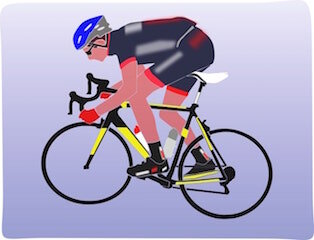Mountain biking socks should meet 3 criteria:
Wicks away sweat and moisture
Mid-height (minimum) as this protects against thorns, poisonous plants, and other trail hazards and protrusions
Thin - Especially if wearing shoes for a clipless pedal system
“There’s not a lot on cycling socks as there’s not a lot of function outside of sweat, thin enough in shoe”
Do you really need a mtb specific sock?
“Yep, they make special cycling socks, too. Truth be told, you don’t need them. But do be sure to wear a merino wool or synthetic athletic-style sock that is designed to wick moisture away from your feet to keep them dry ”
Ricardo - Guide with our mountain bike tours in ‘The Patagonia”
The concept of sport-specific socks emerged during the 1970s with the invention of the Roll Top Sock by James Throneburg. Whose patented designs placed extra padding in strategic locations to provide protection during sports, such as running, skiing, tennis, and basketball.
In active sports, like hiking, cycling and mountain biking, the sweat generation rate can be very high, so moisture management becomes the most important function.
“Blisters are the most common complaint in runners with an incidence of up to 39%. The incidence of foot blisters has been found to range between 48% and 77% during basic military training ”
In hiking, jogging, and trail running, you also have to worry about frictional blisters from shearing, compression, and scraping forces.
These forces cause frictional blisters, which is further compounded by perspiration.
However, mountain bikers and cyclists don’t have to worry about frictional blisters, since these sports don’t involve your feet coming into contact with the ground through striding.
Since you don’t have to wear socks that are designed to reduce or minimize frictional blisters, your 4 main concerns are sock height, moisture wicking properties, comfort, and sock thinness.
So..back to the original question, “do you really need a mountain bike specific sock?”
Unless you’re bike touring or wearing the same soggy sock hour after hour for multiple days……Any thin, mid-height, comfortable sock will get the job done.
Riding your local trails for a few hours during normal riding conditions doesn’t require any bicycle specific sock. Most riders wear socks more for style and comfort than performance, which is perfectly fine since mountain bike specific sock don’t confer any ‘special’ benefits.
Benefits of athletic socks
Ricardo at a beach in Puerto Montt, Chile
Athletic socks provide:
Sweat management
Thermal balance
Antimicrobial performances
Protection against poison ivy, thorns, branches, and other trail hazards while wearing mid-height or taller socks
Anti-frictional - Prevents blisters (non-factor in mountain biking or cycling)
Moisture management, MTB socks & hot climates
During vigorous physical activity in hot and humid conditions, your feet can sweat out up to 5/6 of a cup of water per hour (200 cc/hour).
While biking through the deserts of Utah or the humid rain-forests of North Carolina, no sock will be able to absorb nearly a cup of sweat.
Instead, you must choose a sock that has ‘wicking’ properties, as these socks will actually move the moisture away from your feet.
One of the main reasons to ride wearing athletic socks is the moisture management aspect. The palm of your hands and the soles of your feet contain the highest density of sweat glands in your entire body.
The ability of a sock to properly ‘wick’ sweat is one of the most important aspects of any athletic sock.
Moisture build-up within a shoe environment is primarily due to the high perspiration rate of the feet and a warm or humid environment generated in an enclosed shoe. Sweat from the body will vaporize into the atmosphere much quicker compared to the sweat accumulated within your shoes.
socks & antimicrobial properties
“The term ‘antimicrobial’ refers to a broad range of technologies that provide varying degrees of protection for textile materials against microorganisms”
When you’re pedaling on your mountain bike, your feet get hot and begin to sweat.
Your sweaty feet are creating a warm and moist habitat for micro-organisms, such as bacteria, fungi, and viruses.
Bacteria releases foul-smelling toxins, which get absorbed into your shoes and socks.
The function of an antibacterial sock is to kill bacteria before it has a chance to grow. If you find that your riding socks are extra stinky, you could consider trying an antibacterial sock.
“It should be noted that some specialists do not recommend everyday use of antibacterial socks, because these antibacterial properties affect the natural skin microflora ”
Bamboo Socks & Antibacterial Characteristics
“The growth rate of micro-organisms on 100% cotton is the highest.”
For example, bamboo has many antibacterial qualities, which this fabric can retain, even after numerous washings.
The antibacterial rate of bamboo is 99.8%. Even when it’s interwoven into socks, it’s still highly effective at reducing odors and preventing bacteria from growing.
“Even after 50 washing times, bamboo fiber still has outstanding property of antimacrobial.”
Final Thought
Most mountain bike and cycle-specific socks are designed for style/image first and moisture management second. If you’re looking for a sock that will be antimicrobial and effective at wicking perspiration away, you’d be better off wearing a pair of hiking socks.
Outdoor recreational activities, such as hiking, running, tennis, and basketball, for example, all require a more complex and specific sock, as these sports all involve your feet coming into repeated contacts with the ground.
As Dr. Emily Splichal noted, outside of thickness and sweat management, your MTB/cycle sock doesn’t need to do much else…..which means any thin sock will do.
Jesse is the Director of Pedal Chile and lives in La Patagonia. Jesse has a Master of Science in Health and Human Performance and a Bachelor of Science in Kinesiology. Hobbies: Mountain biking, reading, researching, weight-lifting, craft beer, snowboarding, and lover of Merino wool socks.
Sources:
Arafa Badr, Alaa. “Anti-Microbial and Durability Characteristics of Socks Made of Cotton and Regenerated Cellulosic Fibers.” Alexandria Engineering Journal, vol. 57, no. 4, Dec. 2018, pp. 3367–3373. link
Tantawy, S. A. El, et al. “Investigation of the Functional Performance Properties and Antimicrobial Behavior of Sports Socks Knitted from Eco-Friendly Materials.” International Journal of Advances in Scientific Research and Engineering, vol. 06, no. 01, 2020, pp. 59–76,
Van Amber, Rebecca R, et al. “Thermal and Moisture Transfer Properties of Sock Fabrics Differing in Fiber Type, Yarn, and Fabric Structure.” Textile Research Journal, vol. 85, no. 12, 5 Dec. 2014, pp. 1269–1280.
Van Tiggelen, Damien, et al. “Sock Systems to Prevent Foot Blisters and the Impact on Overuse Injuries of the Knee Joint.” Military Medicine, vol. 174, no. 2, Feb. 2009, pp. 183–189.
Wilkie, Charles A, et al. Handbook of Research on Functional Materials : Principles, Capabilities and Limitations. Toronto ; Waretown Nj, Apple Academic Press, Cop, 2016.
Yeager, Selene. Every Woman’s Guide to Cycling : Everything You Need to Know, from Buying Your First Bike to Winning Your First Race. New York, New American Library, 2008.














